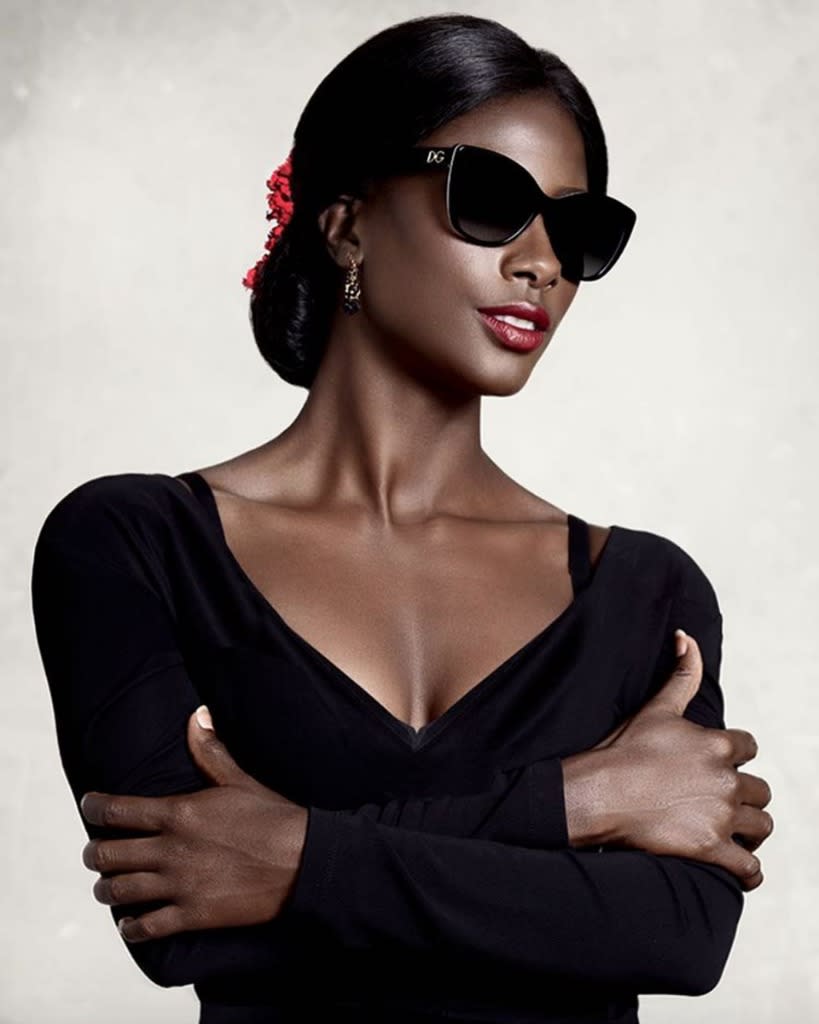Black Model Recreates Top Fashion Campaigns To Highlight the Need for More Diversity in the Industry

Deddeh Howard, an American model born and raised in West Africa, is tired of black models being marginalized, so she’s doing something about it. Howard is raising awareness for more diversity in the fashion industry by publishing a series of photos to her website in which she recreates major advertising campaigns that originally starred A-list white models and actresses. She calls her project “Black Mirror,” as it reflects what each ad would look like if it were to feature a black woman instead a white one.
#blackmirror photo project about diversity in the fashion industry with @secretofdd
A photo posted by Raffael Dickreuter (@raffael3d) on Dec 6, 2016 at 2:19pm PST
Howard was shot by her partner, photographer Raffael Dickreuter, who expertly captured his muse in poses and environments that are almost identical to those in the initial images. The beauty is seen straddling a motorcycle in a reproduction of a Guess ad starring girl-of-the-moment Gigi Hadid and a bicycle in a photo that pays homage to a Louis Viutton campaign fronted by actress Michelle Williams. She embraces herself while rocking a pair of dark shades like model Bianca Balti did in a Dolce & Gabbana ad and looks every bit as striking as Gisele Bundchen in a reenactment of a campaign for Vivara.
A photo posted by Deddeh Howard (@secretofdd) on Dec 6, 2016 at 3:56pm PST
Howard’s inspiration for the project came from her own experiences in the modeling industry, making the rounds and pitching herself to one agency after another that turned her down. She recalls that scouts and agents would “immediately” compare her to “that one or two black model that they had on the roster,” she writes on her site. “Even though I was told by those agencies that I have an amazing look and [they] wish they could represent me, they already have a black model. Besides having an abundance of white models. It seemed as if one or two black models on the roster are enough to represent us all. When you are told that, trust me, it feels bizarre.”
Far too often, she writes, African Americans are negatively portrayed in the media, whether they’re “being targeting by police” or even getting “shot or arrested.” She laments the under-representation of black people at high-profile show business events like the Oscars, and suggests that defining moments for women of color in media and entertainment — such as black model Jasmine Tookes wearing the diamond-and-emerald-encrusted Fantasy Bra, the showpiece at Monday’s Victoria’s Secret Fashion Show — are few and far between.
A photo posted by Deddeh Howard (@secretofdd) on Dec 6, 2016 at 11:51pm PST
Howard writes, “as a girl I always wondered, why the big brands such as Gucci, Chanel, Louis Vuitton, Guess and many others rarely seem to use a black model? And if they do, a very small group of black models does make the cut here and there, but that group seems to remain pretty much identical over a long period of time.” She suggests that modeling may seem trivial when compared to other opportunities, in the realm of things. But inclusiveness in the industry does have significance, and it sends a message.
“The visibility on these commercials and billboards matter as much as having elected a first black President,” Howard writes. “The next generation can only get inspired and reach for the stars themselves if they believe they can do it too. For that reason diversity in ad campaigns is in my opinion much more important than you might think. The same goes for representation in movies and politics … but that’s a different discussion.”
Howard describes herself on Instagram as a “Fashion/Yoga/Lifestyle/Med Student,” and features many photos of herself in elaborate yoga poses in addition to modeling shots on social media and her website. She writes that her ancestors are from Liberia, a country in the southern part of West Africa. But to Howard, inclusiveness means making sure all races and ethnicities are represented. “More equal visibility of all races, [be] it white, black, Asian, Latino etc would help all of us [to believe] in our potential,” she writes. And that includes multi-ethnic people, too. “We live in a globalized world with nowadays many interracial couples producing mixed babies. Why can’t the big brands not embrace our diversity more?” Howard wonders.
Mainly, Howard hopes her Black Mirror photo project will reach the upcoming generation of black models. And she is not alone in this aspiration; she has many industry heavyweights in corner. Designer Zac Posen made the statement that “black models matter” by making sure 25 of the 33 models hired to walk his runway show during New York Fashion Week were black. And iconic black supermodel Iman has been an outspoken advocate of equal representation in modeling.
As Howard writes, “Just like a Gisele Bundchen, Kate Moss or Candice Swanepoel gets to travel the world, shoot the most amazing campaigns and live an exciting life to inspire young girls, let’s give the next generation something to believe in.” (See all the images here.)
Follow us on Instagram, Facebook, and Pinterest for nonstop inspiration delivered fresh to your feed, every day.

